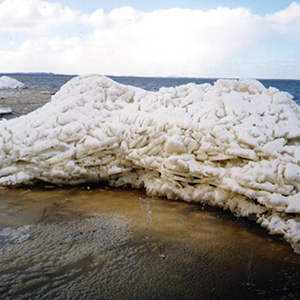Relationships between air temperature and ice conditions on the southern Baltic coastal lakes in the context of climate change

Submitted: 18 October 2021
Accepted: 18 March 2022
Published: 22 April 2022
Accepted: 18 March 2022
Abstract Views: 2686
PDF: 428
HTML: 121
HTML: 121
Publisher's note
All claims expressed in this article are solely those of the authors and do not necessarily represent those of their affiliated organizations, or those of the publisher, the editors and the reviewers. Any product that may be evaluated in this article or claim that may be made by its manufacturer is not guaranteed or endorsed by the publisher.
All claims expressed in this article are solely those of the authors and do not necessarily represent those of their affiliated organizations, or those of the publisher, the editors and the reviewers. Any product that may be evaluated in this article or claim that may be made by its manufacturer is not guaranteed or endorsed by the publisher.
Similar Articles
- Dmitry L. LAJUS, Victor R. ALEKSEEV, Phenotypic variation and developmental instability of life-history traits: a theory and a case study on within-population variation of resting eggs formation in Daphnia , Journal of Limnology: Vol. 63 No. s1 (2004): Diapause In Aquatic Invertebrates
- Sebastian Lenz, Nathalie Dubois, Juergen Geist, Uta Raeder, Phacotus lenticularis content in carbonate sediments and epilimnion in four German hard water lakes , Journal of Limnology: Vol. 79 No. 2 (2020)
- Nicoletta RICCARDI, Giampaolo ROSSETTI, Eudiaptomus gracilis in Italy: how, where and why , Journal of Limnology: Vol. 66 No. 1 (2007)
- Oscar RAVERA, Pier Renato TRINCHERINI, Gian Maria BEONE, Bruno MAIOLINI, The trend from 1934 to 2001 of metal concentrations in bivalve shells (Unio pictorum) from two small lakes: Lake Levico and Lake Caldonazzo (Trento Province, Northern Italy) , Journal of Limnology: Vol. 64 No. 2 (2005)
- Kęstutis ARBAČIAUSKAS, Seasonal phenotypes of Daphnia: post-diapause and directly developing offspring , Journal of Limnology: Vol. 63 No. s1 (2004): Diapause In Aquatic Invertebrates
- Ladislav Hamerlík, Marta Wojewódka, Edyta Zawisza, Sergio Cohuo Duran, Laura Macario-Gonzalez, Liseth Pérez, Krystyna Szeroczyńska, Subfossil Chironomidae (Diptera) in surface sediments of the sinkholes (cenotes) of the Yucatan Peninsula: Diversity and distribution , Journal of Limnology: Vol. 77 No. s1 (2018): Recent advances in the study of Chironomidae: An overview
- Nikolai M. Korovchinsky, Cladocera (Crustacea: Branchiopoda) of South East Asia: history of exploration, taxon richness and notes on zoogeography , Journal of Limnology: Vol. 72 No. s2 (2013): Freshwater Invertebrates of Southeast Asia
- Roumen KALCHEV, Ivan BOTEV, Milena HRISTOZOVA, Wesselin NAIDENOW†, Galerida RAIKOVA-PETROVA, Maya STOYNEVA, Dobrina TEMNISKOVA-TOPALOVA, Teodora TRICHKOVA, Ecological relations and temporal changes in the pelagial of the high mountain lakes in the Rila Mountains (Bulgaria) , Journal of Limnology: Vol. 63 No. 1 (2004)
- Chris J. CURTIS, Roger FLOWER, Neil ROSE, James SHILLAND, Gavin L. SIMPSON, Simon TURNER, Handong YANG, Sergi PLA, Palaeolimnological assessment of lake acidification and environmental change in the Athabasca Oil Sands Region, Alberta , Journal of Limnology: Vol. 69 No. s1 (2010): Impacts of sulphur and nitrogen deposition in western Canada
- Rosario MOSELLO, Aldo MARCHETTO, Maria C. BRIZZIO, Michela ROGORA, Gabriele A. TARTARI, Results from the Italian participation in the International Co-operative Programme on Assessment and Monitoring of Acidification of Rivers and Lakes (ICP Waters) , Journal of Limnology: Vol. 59 No. 1 (2000)
<< < 64 65 66 67 68 69 70 71 72 73 > >>
You may also start an advanced similarity search for this article.

 https://doi.org/10.4081/jlimnol.2022.2060
https://doi.org/10.4081/jlimnol.2022.2060





